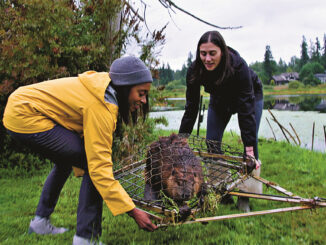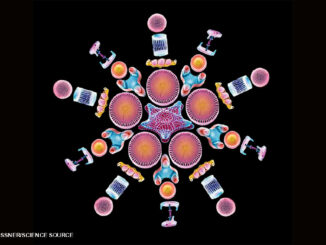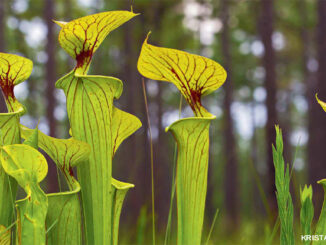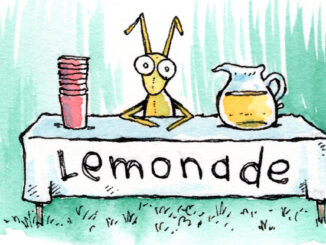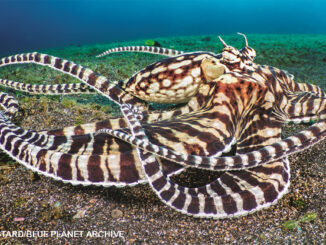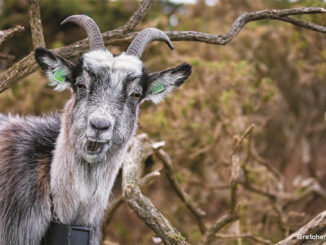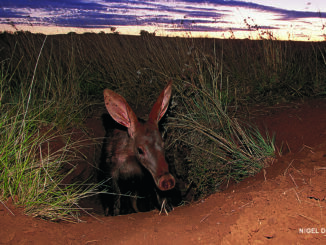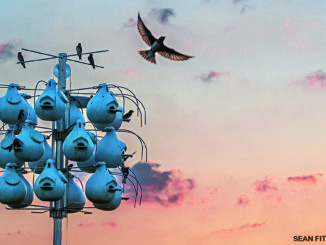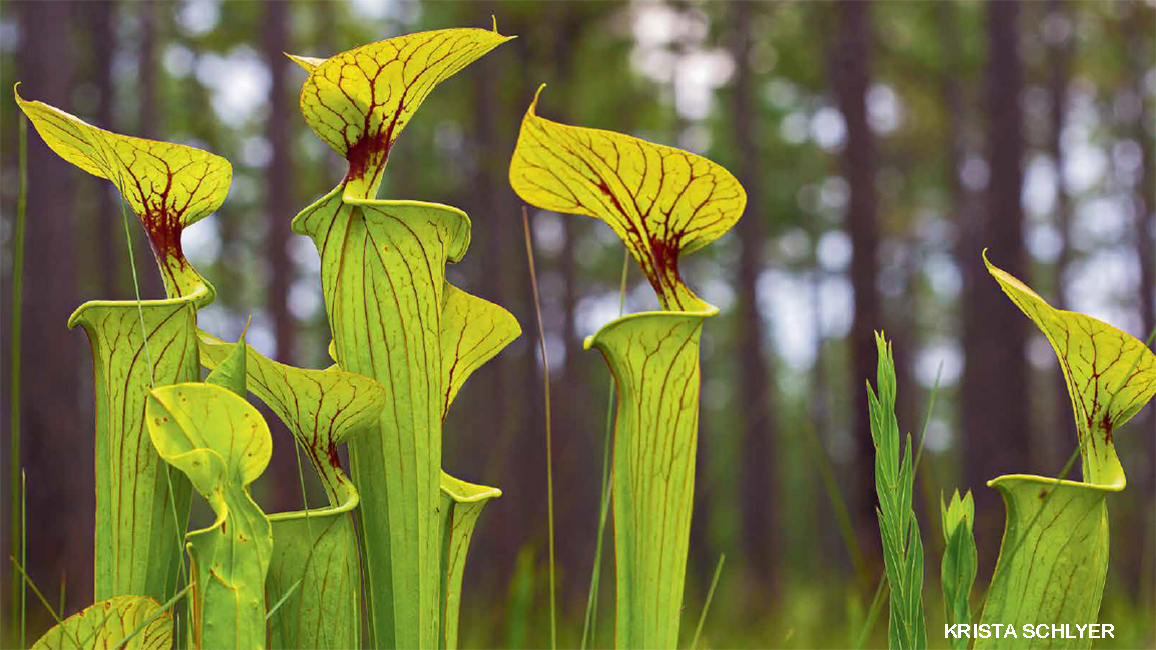
Pitcher This!
By Ellen Lambeth; Photos by Clay Bolt and Krista SchlyerThese plants have a catchy lifestyle. But sometimes life takes some twists and turns.
Animals have to eat, right? Their food has nutrients that keep them alive and healthy. Plants need nutrients, too. They get theirs from the soil, air, and water around them. Some environments are lower in nutrients than others. But that’s no problem for carnivorous (kar-NIHvur-uss) plants. Those are plants that add to their diets by—wait for it—eating animals! Weird, right?
Different types of carnivorous plants exist in warm, wet places around the world. The tall, elegant ones you see above are yellow pitcher plants. They grow in bogs and swamplands of southeastern North America.
TO CATCH A BUG
 Many pitcher plants have flowery-looking tops and give off a sweet smell. Both those things attract nectar-sipping creatures. And those sippers attract predators that may become prey themselves.
Many pitcher plants have flowery-looking tops and give off a sweet smell. Both those things attract nectar-sipping creatures. And those sippers attract predators that may become prey themselves.
When either kind of “victim” (such as the lady beetle at right) enters the plant’s pitcher, it soon discovers that the walls in there are slippery. They also may be lined with downward-pointing hairs that keep the victim from backing out. Eventually, it slips to the bottom, landing in a chemical mix that slowly dissolves its body. Then the plant’s leafy walls can absorb the nutrients. Yum!
IT TAKES ALL KINDS
 There are more than 100 species of pitcher plants in the world, about 10 of which live in the United States. Scientists have discovered that different species produce different scents. That means that each species is likely to attract a specific sipper.
There are more than 100 species of pitcher plants in the world, about 10 of which live in the United States. Scientists have discovered that different species produce different scents. That means that each species is likely to attract a specific sipper.
Take this hooded pitcher plant at right. It seems to be particularly popular among flies and gnats. If one of these insects flies under that hood, it feels safe at first because of all the “windows” it can escape through out the back. Trouble is, those windows don’t open. They’re just white spots that let a little light shine through. The creature may then try flying out the way it came in. Nope, it keeps hitting its head on the hood and then slipping back down. Trapped!
MORE THAN MEETS THE EYE

There’s often more going on with pitcher plants than just trapping and digesting. Take the blue mud dauber, poised on the yellow pitcher plant above. This wasp was attracted to the rim of that perfumy “flower.” If it zips inside, it could suffer the usual victim’s fate. Or it could just use its chewing mouthparts to open an escape hatch.
How about the green lynx spider on another yellow pitcher (above)? It has no need for nectar. It stays hidden in plain sight while waiting for “lunch” to arrive. Then—pounce—gotcha! (below)
The fly may have come to lay eggs in the lovely “flower.” Not this time, though: The final score here is spider-1, fly-0.
AT YOUR SERVICE
Pitcher plants get the nutrients they need from the creatures they catch. But, as you saw above, some creatures take advantage of pitcher plants. Here’s a jumping spider using a white-topped pitcher plant as its stalking ground (below). Its prize? A smaller jumping spider.
SIP, DON’T SLIP
A sphinx moth lives on the nectar it finds in flowers—especially ones with long tubes, such as honeysuckle. But this white-topped pitcher plant’s fake “flower” is open for business, too (above). The moth has a tongue-like sipper—called a proboscis (proh-BAH-siss)—that is verrrry long! The insect doesn’t have to land anywhere, risking a slip-in. It just hovers in midair with its sipper down in there.
UNINVITED “GUESTS”
 The pitcher plant moth at left has no trouble hanging out in a pitcher. In fact, that’s pretty much where it spends its life. The moth is easy to identify by its curious shape and colors—and by its location, of course.
The pitcher plant moth at left has no trouble hanging out in a pitcher. In fact, that’s pretty much where it spends its life. The moth is easy to identify by its curious shape and colors—and by its location, of course.
A female moth lays her eggs just inside a pitcher’s opening. When the eggs hatch, the caterpillars’ special clingy feet keep them from slipping into the danger zone. (The adults have clingy feet, too.) As the caterpillars grow, they eat up the inner walls of the pitcher. They also spin a silk layer across the opening (below right) to keep out other troublemakers.
 When the caterpillars are ready to change into adults, they chew a hole in the bottom of the pitcher to let the dangerous liquid drain out. Then they make their cocoons there and wait for the final stage of their lives.
When the caterpillars are ready to change into adults, they chew a hole in the bottom of the pitcher to let the dangerous liquid drain out. Then they make their cocoons there and wait for the final stage of their lives.
You can probably guess that these moths don’t do the plant any favors. A damaged pitcher eventually will dry up and keel over. But the plant itself can just grow a new pitcher. Ta-da!
THIS PITCHER’S A CATCHER!
How hard do you think it is to catch a fly? Are you as talented as a pitcher plant? Find out by making your own pitcher plant and playing “catch” with it. Get a cut-out pattern and instructions here!







